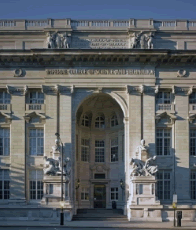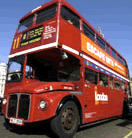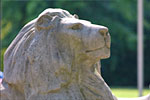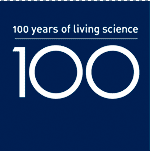Rogers Knight
(City and Guilds College, 1934 - '38)
Rogers Knight shares his memories of playing pranks on policemen in the 1930s
Watch the Real Player stream of Rogers Knight or read the transcript below...
Interviewer: Can you tell us something about College life when you were here including the buildings, the students, the teaching staff, the courses, and then later on describe your association with the old students.
Rogers Knight: It was a different world before the war, much more leisurely, much more formal, the way I’m dressed today is what I would have expected an undergraduate to be wearing in the 1930’s. The buildings we had, the Royal College of Science, the original Guild's Building and the Royal School of Mines were built with care and attention. They looked as though they expected to be there for the next 100 years. Unfortunately the only one that’s left is the Royal School of Mines. Architects obviously took pride in their work, looking at today’s buildings; I cannot imagine any architect taking pride in them.
Guild's Building and the Royal School of Mines were built with care and attention. They looked as though they expected to be there for the next 100 years. Unfortunately the only one that’s left is the Royal School of Mines. Architects obviously took pride in their work, looking at today’s buildings; I cannot imagine any architect taking pride in them.
Before the war, the whole atmosphere was different; I mean the use of christian names when you first meet in our day was unknown. You addressed each other if you were equals, by your surname and if you were addressing someone who was older than you, occupied a higher position than you, then it was ‘Mr’ and the skilled tradesman – the butcher, the baker, you always referred to him as ‘Mr’.
Prices were entirely different of course, the last time I looked the inflation figure was 30 to 35. In our day a pint of beer, in today’s money was about 7p, probably less, and as low as 3p. Petrol was 7p a gallon, and you could get a very good meal in a pub for one and sixpence. In fact as far as I remember, those of us who were lucky enough to have the ear of the caterer, we dined in the college or in the week on fillet steak for 2 shillings. (Photo above; Royal School of Mines, photograph by Christian Richters)
So that is what it was like in those days. The traffic was different, if you were doing a long distance car journey, in those days without any motorways, if you had the right car you  expected to plot to average 55 miles an hour, start to stop, from the centre of London to the centre of Sheffield. You can’t even do that today using the motorways. We were talking about if you took a bus in those days; I picked up a bus in Castelnau, we lived in Lonsdale Road in Barnes, and I think the bus fare from Castelnau to the College was 2p, admittedly I didn’t very often use the bus, because I was one of the students who were lucky enough to own their own car. So I used to drive to college, and I if could not park, within 50 feet of the main College entrance, I felt very peaked indeed.
expected to plot to average 55 miles an hour, start to stop, from the centre of London to the centre of Sheffield. You can’t even do that today using the motorways. We were talking about if you took a bus in those days; I picked up a bus in Castelnau, we lived in Lonsdale Road in Barnes, and I think the bus fare from Castelnau to the College was 2p, admittedly I didn’t very often use the bus, because I was one of the students who were lucky enough to own their own car. So I used to drive to college, and I if could not park, within 50 feet of the main College entrance, I felt very peaked indeed.
Interviewer: Well what were the other students like, you mentioned numbers?
Rogers Knight: The whole student body was around 1200. 100 in the Royal School of Mines, and the Royal College of Science and Guilds were about the same size. So you’re talking 450 each. When you consider that it was a 3 year course, that means that in each year, there was about 150 and if you consider the 6 different departments, your down to the fact that the students actually in your department and your year where somewhere around 30,40, 50 at the outside.
I well remember the College Porter, dressed in his formal red morning coat, standing on the College steps every morning, greeting every student by name.
Continue watching the Real Player Stream of Rogers Knight or read the transcript below...
Interviewer: Did you and your Fellowes do anything, get up to things you shouldn’t have and knock policeman’s hats off or anything like that?
Rogers Knight: We had extremely good relations with the police actually. Whenever there was anything on at the Albert Hall, you could be sure that during their rest period these three or four policemen would be in the union bar having a beer. We got up to some pranks I suppose, one famous one was when the pelican beacon (pedestrian crossing) first came in. The students organised a walk from Albert Hall into Kensington Gardens and it was something like 25 minutes before finally somebody decided that the queue had to be broken and let the traffic proceed.
We also had some fun with the police because there was a time when we had a 20 mile an hour speed limit in this country no matter where you were and they finally dropped that in the 1930’s and there was no speed limit. You could be had for dangerous or careless driving but there was no speed limit. But naturally a number of idiots did stupid things and so they brought in the 30 mile limit, outside that unlimited. In those days they had a police trap in Exhibition Road, and there was a policeman who stood outside what was then the Huxley Building and one with a stop watch, roughly at Prince Consort Road and then slightly further up was the third policeman. Well the first policeman if he thought was exceeding 30 miles an hour, he flashed his handkerchief, the second policeman tripped his stopwatch as you passed him he tripped you again. And if you were exceeding the 30 mile limit the third policemen stopped you. Well this was just too tempting, the usual trick was you made absolutely certain that you passed the first policeman at 35 or 40 miles an hour, if he waved his handkerchief you simply stopped in front of the college, and frustration all round. If he didn’t wave his handkerchief you just kept going and you pass the second policeman at about 50 miles per hour, and there was nothing he could do about it.
© 2007 Imperial College London

Through the first decade of the twenty-first century the campaign seeks to philanthropically raise £207 million from Imperial’s alumni, staff and friends, and donations from charitable foundations and industry.
Where your support can make a differenceGive now

Imperial’s Centenary Year provides an opportunity to recognise and celebrate members of the Imperial community.
View staff and student portraits
